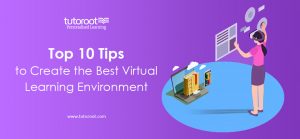Top 10 Tips to Create the Best Virtual Learning Environment
In today’s fast-paced world, the landscape of education has evolved significantly, with technology playing a pivotal role in shaping the way we learn. One of the most notable advancements in the field of education is the emergence of virtual learning environments. As the world continues to adapt to remote learning, creating an effective virtual learning environment has become a crucial consideration for educators and learners alike. In this article, we will delve into the concept of a virtual learning environment, its importance, and provide you with the top 10 tips to create the best virtual learning environment.
Understanding the Learning Environment
Before diving into the realm of virtual learning environments, let’s establish what a learning environment entails. A learning environment encompasses the physical, psychological, and social conditions that impact the learning process. Traditionally, learning environments were confined to physical classrooms, but with the advent of technology, these environments have transcended physical boundaries.

Defining Virtual Learning Environment (VLE)
A Virtual Learning Environment (VLE) refers to a digital platform that replicates the educational experience of a traditional classroom in an online space. It enables educators to deliver content, engage with students, and facilitate interactions, all while providing learners the flexibility to access educational materials from the comfort of their own homes.
Importance of a Virtual Learning Environment
The significance of a virtual learning environment cannot be overstated. It bridges the gap between geographical constraints and educational opportunities. It enables learners to access quality education regardless of their location, making education more inclusive and accessible.
Types of Learning Environments
Before delving into the tips for creating an effective virtual learning environment, it’s essential to understand the various types of learning environments:
- Traditional Classroom: The traditional physical classroom where educators and students interact face-to-face.
- Online Learning: Education delivered entirely through digital platforms, often asynchronous and self-paced.
- Blended Learning: A combination of traditional and online learning, offering a flexible and balanced approach.
- Virtual Learning Environment (VLE): A dedicated online space that replicates the classroom experience.
Tips to Create the Best Virtual Learning Environment
Creating a successful virtual learning environment (VLE) is more important than ever as online education continues to evolve. Whether you’re an educator or a student, having a well-designed VLE can greatly enhance the learning experience. In this article, we’ll explore some essential tips to help you establish the best virtual learning environment possible.
User-Friendly Interface
A user-friendly interface is paramount for a seamless learning experience. Ensure that your VLE is easy to navigate, with clear labels and intuitive menus. Students and educators should be able to find resources and tools without confusion.
Engaging Content
To keep learners motivated, incorporate engaging content such as videos, interactive quizzes, and multimedia presentations. Dynamic content captures attention and makes learning more enjoyable.
Clear Communication Channels
Effective communication is key in any learning environment. Provide various communication channels, such as discussion forums, chat rooms, and direct messaging, to facilitate interaction between students and instructors.
Personalized Learning Paths
Every learner is unique, so offer personalized learning paths. Adaptive assessments and customized content recommendations help students progress at their own pace and cater to their individual needs.
Collaborative Spaces
Collaboration is a crucial skill in the modern world. Create virtual spaces where students can collaborate on projects, share ideas, and work together on assignments. These collaborative experiences enrich the learning process.
Regular Feedback Mechanism
Feedback is essential for improvement. Incorporate regular assessments and feedback loops to help students track their progress and identify areas that need more attention.
Tech Support Availability
Technical issues can disrupt the learning process. Ensure that technical support is readily available to address any problems students or educators might encounter while using the platform.
Access to Resources
A robust library of resources is essential for a comprehensive learning experience. Provide access to e-books, articles, research papers, and other relevant materials to supplement the curriculum.
Diverse Assessment Methods
Use a variety of assessment methods to cater to different learning preferences. Mix quizzes, essays, presentations, and practical assignments to assess students’ understanding from various angles.
Promote Student Autonomy
Encourage students to take charge of their learning journey. Allow them to explore topics of interest, set their own goals, and manage their progress. This autonomy fosters a sense of responsibility and ownership.
Considerations while Creating a Learning Environment
- Pedagogical Approach: Align the virtual learning environment with a suitable pedagogical approach that supports the desired learning outcomes.
- Resource Availability: Ensure that learners have access to the necessary resources, such as a reliable internet connection, required software, and course materials.
- Time Management: Provide a clear schedule and expectations for the course, helping learners manage their time effectively.
- Community Building: Foster a sense of belonging by promoting interactions, collaborative projects, and discussions among learners.
- Security and Privacy: Prioritize the security and privacy of learners’ data by using secure platforms and adhering to data protection regulations.
Conclusion
The evolution of education has brought forth the era of virtual learning environments, enabling learners to access education from diverse locations. Creating an effective virtual learning environment requires careful planning, technological proficiency, and a deep understanding of pedagogical principles. By following the top 10 tips outlined in this article, educators can craft a dynamic, engaging, and inclusive virtual learning environment that empowers learners to thrive in the digital age. As technology continues to reshape education, the pursuit of an optimal learning environment remains paramount.
As everyone knows there are many VLE platforms that exist, Tutoroot is one of the finest platforms. Moreover, it includes all types of services, visit the Tutoroot website today to know more about it.
